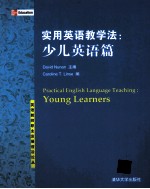

实用英语教学法 少儿英语篇PDF电子书下载
- 电子书积分:10 积分如何计算积分?
- 作 者:DavidNunan主编;CarolineT.Linse编
- 出 版 社:北京:清华大学出版社
- 出版年份:2013
- ISBN:9787302308881
- 页数:216 页
Chapter One The child as a language learner 1
1. Introduction 2
2. What is developmentally appropriate instruction? 2
3. Learning about children's development and interests 6
4. Children's language learning and acquisition 12
5. Making input meaningful to learners 13
6. Supporting children's language acquisition and learning 14
7. Conclusion 16
Further Readings 17
Helpful Websites 17
References 18
Chapter Two Teaching listening to young learners 21
1. Introduction 22
2. What is listening? 22
3. Background to the teaching of listening 25
4. The development of listening skills 27
5. Classroom techniques and activities 29
6. Listening in the classroom 40
7. Conclusion 43
Further Readings 43
Helpful Websites 43
References 44
Chapter Three Teaching speaking to young learners 45
1. Introduction 46
2. What is speaking? 46
3. Background to the teaching of speaking 47
4. The development of speaking skills 49
5. Classroom techniques and activities 52
6. Managing speaking activities 62
7. Speaking in the classroom 63
8. Conclusion 66
Further Readings 66
Helpful Websites 66
References 67
Chapter Four Teaching reading to young learners 68
1. Introduction 69
2. What is reading? 69
3. Background to the teaching of reading 71
4. The development of reading skills 75
5. Classroom techniques and activities 78
6. Reading in the classroom 90
7. Conclusion 94
Further Readings 94
Helpful Websites 94
References 95
chapter Five Teaching writing to young learners 97
1. Introduction 98
2. What is writing? 98
3. Background to the teaching of writing? 99
4. Development of writing skills 101
5. Classroom techniques and activities 110
6. Writing in the classroom 114
7. Conclusion 117
Further Readings 118
Helpful Websites 118
References 119
Chapter Six Teaching vocabulary to young learners 120
1. Introduction 121
2. What is vocabulary? 121
3. Background to the teaching of vocabulary 122
4. Principles for teaching vocabulary 123
5. Classroom techniques and activities 128
6. Vocabulary in the classroom 132
7. Conclusion 134
Further Readings 135
Helpful Websites 135
References 135
Chapter Seven Assessing young learners 137
1. Introduction 138
2. What is assessment? 138
3. Background to assessing young learners 141
4. Formal assessment 143
5. Classroom-based assessment 145
6. Assessment in the classroom 157
7. Conclusion 162
Further Readings 162
Helpful Websites 163
References 163
apter Eight Working with parents of young learners 165
1. Introduction 166
2. Why are parents important? 166
3. Ways that parents can be involved and connected 167
4. Creating a teacher-parent partnership 170
5. Conclusion 184
Further Readings 184
Helpful Websites 184
References 185
Chapter Nine Key issues in teaching young learners 186
1. Introduction 187
2. Classroom management 187
3. Special needs 192
4. Multiple intelligences 197
5. Tutoring 198
6. Technology 199
7. Professional support 200
8. Conclusion 201
Further Readings 201
Helpful Websites 201
References 203
Children's songs and finger-plays 204
Glossary 207
Index 211
Credits 216
- 《高级英语阅读与听说教程》刘秀梅编著 2019
- 《思维导图 超好用英语单词书》(中国)王若琳 2019
- 《培智学校义务教育实验教科书教师教学用书 生活适应 二年级 上》人民教育出版社,课程教材研究所,特殊教育课程教材研究中心编著 2019
- 《少儿电子琴入门教程 双色图解版》灌木文化 2019
- 《初中生英语作文 提高篇》清瑶主编 2019
- 《指向核心素养 北京十一学校名师教学设计 英语 七年级 上 配人教版》周志英总主编 2019
- 《培生高级英语语法 练习册》培生教育 2019
- 《365奇趣英语乐园 世界民间故事》爱思得图书国际企业 2018
- 《新课标背景下英语教学理论与教学活动研究》应丽君 2018
- 《幼儿英语游戏活动指导与实训》苏小菊,任晓琴主编;颜晓芳,覃静,谢恬恬,钟博维副主编 2020
- 《大学计算机实验指导及习题解答》曹成志,宋长龙 2019
- 《指向核心素养 北京十一学校名师教学设计 英语 七年级 上 配人教版》周志英总主编 2019
- 《大学生心理健康与人生发展》王琳责任编辑;(中国)肖宇 2019
- 《大学英语四级考试全真试题 标准模拟 四级》汪开虎主编 2012
- 《大学英语教学的跨文化交际视角研究与创新发展》许丽云,刘枫,尚利明著 2020
- 《北京生态环境保护》《北京环境保护丛书》编委会编著 2018
- 《复旦大学新闻学院教授学术丛书 新闻实务随想录》刘海贵 2019
- 《大学英语综合教程 1》王佃春,骆敏主编 2015
- 《大学物理简明教程 下 第2版》施卫主编 2020
- 《指向核心素养 北京十一学校名师教学设计 英语 九年级 上 配人教版》周志英总主编 2019
